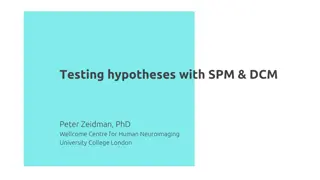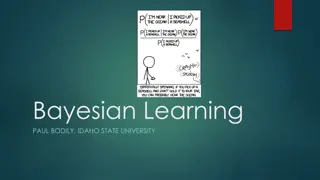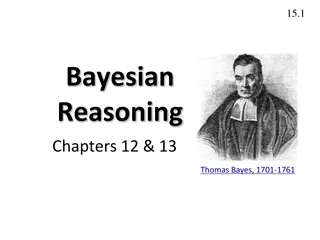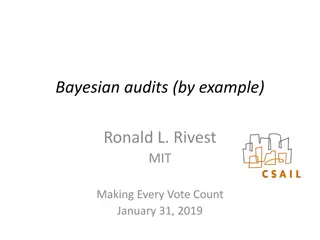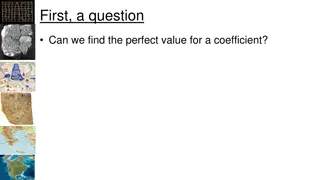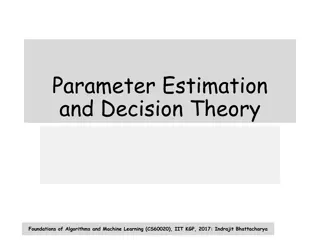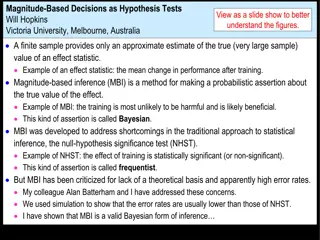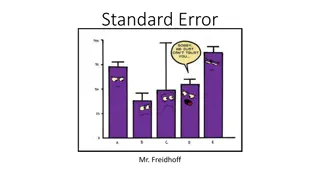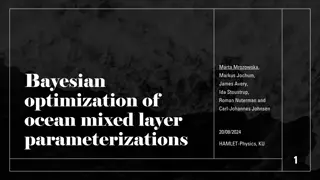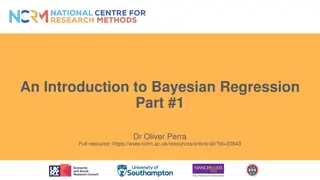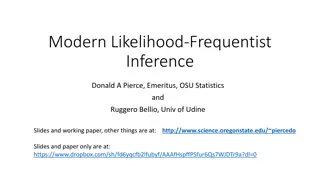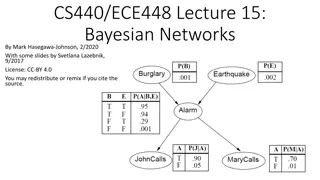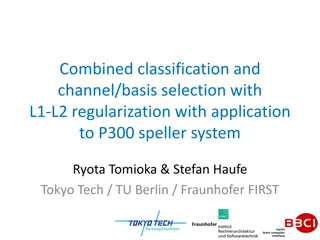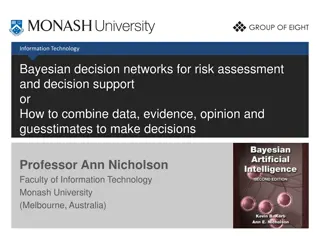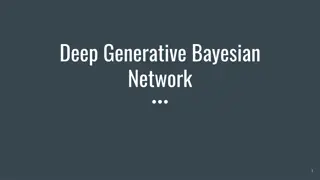Comparison of Frequentist and Bayesian Regularization in SEM
Regularization techniques are increasingly utilized in structural equation modeling (SEM) for producing sparse solutions, overcoming collinearity, and enhancing generalizability. This overview explores the application of both frequentist and Bayesian approaches in SEM, discussing Regularized SEM (RegSEM) and Bayesian SEM, along with their respective regularization methods such as Ridge and Lasso penalties.
Download Presentation

Please find below an Image/Link to download the presentation.
The content on the website is provided AS IS for your information and personal use only. It may not be sold, licensed, or shared on other websites without obtaining consent from the author.If you encounter any issues during the download, it is possible that the publisher has removed the file from their server.
You are allowed to download the files provided on this website for personal or commercial use, subject to the condition that they are used lawfully. All files are the property of their respective owners.
The content on the website is provided AS IS for your information and personal use only. It may not be sold, licensed, or shared on other websites without obtaining consent from the author.
E N D
Presentation Transcript
Comparison of frequentist and Bayesian regularization in structural equation modeling. Ross Jacobucci, Kevin Grimm, & John J. McArdle IMPS 2016 Asheville, NC
Overview Regularization has become a popular tool in regression and graphical modeling for a number of reasons: Produces sparse solutions Can overcome collinearity P > N; Estimable and more efficient with large P Increased generalizability Slight increase in bias for larger decrease in variance Despite this, it has seen little application in psychometrics outside of sparse PCA or EFA Although three recent applications to SEM: Regularized Structural Equation Modeling (Jacobucci, Grimm, & McArdle, 2016) Bayesian Factor Analysis with Spike-and-Slab Prior (Lu, Chow, & Loken, 2016) Penalized Network Models (Epskamp, Rhemtulla, & Borsboom, Under Review)
Regularized Structural Equation Modeling (RegSEM) Applies both Ridge and Lasso penalties to various parameters in SEM (Jacobucci, Grimm, & McArdle, 2016). General form of the equation: Maximum Likelihood fit function ???= log + ?? ? 1 log ? RegSEM ???????= ???+ ? Where ? is (|| ||1) for Lasso or (|| ||2) for Ridge and parameters from either the A matrix (factor loadings or regressions) or S matrix (variances and covariances) in RAM notation Implemented as the regsem package in R ?
Bayesian SEM and Regularization Bayesian SEM as implemented in Mplus (Muthen & Asparouhov; 2012) Use of small variance priors on non-target parameters Equivalent to the use of ridge penalties in frequentist framework Only possible to use Normal distribution priors for factor loadings Bayesian factor analysis with spike-and-slab prior Lu, Chow, & Loken (2016) spike for parameters set to 0 slab higher variance normal distribution for non-zero parameters Similar to SEM heuristic search algorithms (i.e. Marcoulides & Ing, 2011) in frequentist framework BSEM Lasso Use of the Laplace (double exponential) distribution on target parameters By decreasing the variance of the prior, will move parameter estimates close to 0 Shown similarity between Bayes and frequentist lasso in context of regression E.g. Park & Casella (2008)
Purpose Show equivalence with RegSEM Ridge and Mplus BSEM To date, no work with Bayesian Lasso in SEM (BSEM Lasso) As an illustrative example: Show similarity between RegSEM Lasso and BSEM Lasso Holzinger-Swineford (1939) How do they compare in choosing true loadings of 0? Small simulation comparing RegSEM and BSEM Lasso on choosing factor loadings = 0
Bayesian Priors for Regularization Lasso penalties Laplace dist. prior Ridge penalties = Normal dist. prior
Ridge Equivalence Lu, Chow, & Loken (2016) have already pointed out equivalence of BSEM w/ small variance priors and Ridge regularization Requires putting small variance normal priors on specific parameters Can be done in both Mplus and blavaan (JAGS) Different default priors, but as long as they are noninformative there is close equivalence Get same estimates and fit across Bayesian and frequentist implementations Use type= ridge in regsem package Simple Example: First 6 scales from Holzinger Swineford (1939) dataset in lavaan package
Ridge Equivalence Contd *Penalized parameters in bold
Lasso Comparison One factor model with first 6 scales from Holzinger Swineford (1939) Penalize all loadings while setting factor variance to 1 Use cv_regsem function from the regsem package to test 65 penalty values Bayes SEM Lasso implemented using the blavaan package in R Uses JAGS in background and generates model scripts Test 30 different values of precision
RegSEM Lasso Parameter Trajectory - Holzinger Swineford (1939) Data
BSEM Lasso Parameter Trajectory - Holzinger Swineford (1939) Data
Simulation Used simulateData() from lavaan According to factor structure N = 200 2 ways to record accuracy Simulated loadings of 0 not measured as 0 in final model Simulated loadings of 0.2 measured as 0 in final model RegSEM Just use BIC to choose final model BSEM Lasso use posterior mode parameter estimates and whether credible interval includes 0 BIC, DIC, WAIC, LOOIC, log likelihood and marginal log likelihood from blavaan package Both methods used 30-60 variances/penalties
Posterior Mode Estimates RegSEM BIC BIC DIC LOOIC WAIC LogL MargLogLik Type 1 19% 99% 98% 98% 98% 20% 99% Type 2 4% 0% 0% 0% 0% 7% 0% Whether 95% Credible Interval Does Not Contain 0 BIC DIC LOOIC WAIC LogL MargLogLik Type 1 0% 0% 1% 1% 0% 4% Type 2 2% 1% 17% 17% 33% 11% Note. BIC = Bayesian Information Criterion; DIC = Deviance Information Criterion; LOOIC = Leave-One-Out Cross- Validation; WAIC = Watanabe-Akaike Information Criterion; LogL = Loglikelihood; MargLogLik = Marginal Loglikelihood
Discussion Just as in Regression, the BSEM Lasso seems to be a hybrid between frequentist Ridge and Lasso Rarely will estimate posterior modes as close to 0 However, using credible interval is highly accurate in determining true zero loadings Didn t compare to noninformative prior or Normal (Ridge) priors Similar run times Convergence slower for both methods when penalty/prior becomes more restrictive However, every BSEM Lasso model converged Advantage of BSEM Lasso is that standard errors are available Both methods available in open-source software Spike and Slab prior for SEM is not yet
Future Directions Model Identification needs guidelines Use of informative priors allows for fitting models that wouldn t otherwise be identified Same with use of penalties in RegSEM Prior variance selection in BSEM No guidelines Standard errors in RegSEM Not a problem in Ridge or Lasso BSEM Worth investigating hierarchical Lasso priors for BSEM Eliminates need to test multiple prior variances
Acknowledgements Thanks to Ed Merkle for help in tailoring the blavaan package to the analyses used in this presentation Ross Jacobucci was supported by funding through the National Institute on Aging Grant Number T32AG0037.
References Epskamp, S., Rhemtulla, M., & Borsboom, M. (Under Review). Generalized Network Psychometrics: Combining Network and Latent Variable Models. Psychometrika. Downloaded from first authors Researchgate Jacobucci, R., Grimm, K. J., & McArdle, J. J. (2016). Regularized Structural Equation Modeling. Structural Equation Modeling: A Multidisciplinary Journal,23(4), 555-566. Lu, Z. H., Chow, S. M., & Loken, E. (2016). Bayesian factor analysis as a variable-selection problem: Alternative priors and consequences,1-21, doi: 10.1080/00273171.2016.1168279 Muth n, B. O., & Asparouhov, T. (2012). Bayesian structural equation modeling: A more flexible representation of substantive theory. Psychological Methods, 17, 313 335. doi:10.1037/a0026802


